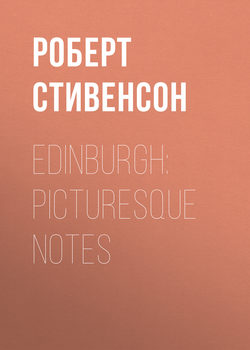Читать книгу Edinburgh: Picturesque Notes - Роберт Стивенсон - Страница 3
CHAPTER III. THE PARLIAMENT CLOSE
ОглавлениеTime has wrought its changes most notably around the precincts of St. Giles’s Church. The church itself, if it were not for the spire, would be unrecognisable; the Krames are all gone, not a shop is left to shelter in its buttresses; and zealous magistrates and a misguided architect have shorn the design of manhood, and left it poor, naked, and pitifully pretentious. As St. Giles’s must have had in former days a rich and quaint appearance now forgotten, so the neighbourhood was bustling, sunless, and romantic. It was here that the town was most overbuilt; but the overbuilding has been all rooted out, and not only a free fair-way left along the High Street with an open space on either side of the church, but a great porthole, knocked in the main line of the lands, gives an outlook to the north and the New Town.
There is a silly story of a subterranean passage between the Castle and Holyrood, and a bold Highland piper who volunteered to explore its windings. He made his entrance by the upper end, playing a strathspey; the curious footed it after him down the street, following his descent by the sound of the chanter from below; until all of a sudden, about the level of St. Giles’s, the music came abruptly to an end, and the people in the street stood at fault with hands uplifted. Whether he was choked with gases, or perished in a quag, or was removed bodily by the Evil One, remains a point of doubt; but the piper has never again been seen or heard of from that day to this. Perhaps he wandered down into the land of Thomas the Rhymer, and some day, when it is least expected, may take a thought to revisit the sunlit upper world. That will be a strange moment for the cabmen on the stance besides St. Giles’s, when they hear the drone of his pipes reascending from the bowels of the earth below their horses’ feet.
But it is not only pipers who have vanished, many a solid bulk of masonry has been likewise spirited into the air. Here, for example, is the shape of a heart let into the causeway. This was the site of the Tolbooth, the Heart of Midlothian, a place old in story and namefather to a noble book. The walls are now down in the dust; there is no more squalor carceris for merry debtors, no more cage for the old, acknowledged prison-breaker; but the sun and the wind play freely over the foundations of the jail. Nor is this the only memorial that the pavement keeps of former days. The ancient burying-ground of Edinburgh lay behind St. Giles’s Church, running downhill to the Cowgate and covering the site of the present Parliament House. It has disappeared as utterly as the prison or the Luckenbooths; and for those ignorant of its history, I know only one token that remains. In the Parliament Close, trodden daily underfoot by advocates, two letters and a date mark the resting-place of the man who made Scotland over again in his own image, the indefatigable, undissuadable John Knox. He sleeps within call of the church that so often echoed to his preaching.
Hard by the reformer, a bandy-legged and garlanded Charles Second, made of lead, bestrides a tun-bellied charger. The King has his backed turned, and, as you look, seems to be trotting clumsily away from such a dangerous neighbour. Often, for hours together, these two will be alone in the Close, for it lies out of the way of all but legal traffic. On one side the south wall of the church, on the other the arcades of the Parliament House, enclose this irregular bight of causeway and describe their shadows on it in the sun. At either end, from round St. Giles’s buttresses, you command a look into the High Street with its motley passengers; but the stream goes by, east and west, and leaves the Parliament Close to Charles the Second and the birds. Once in a while, a patient crowd may be seen loitering there all day, some eating fruit, some reading a newspaper; and to judge by their quiet demeanour, you would think they were waiting for a distribution of soup-tickets. The fact is far otherwise; within in the Justiciary Court a man is upon trial for his life, and these are some of the curious for whom the gallery was found too narrow. Towards afternoon, if the prisoner is unpopular, there will be a round of hisses when he is brought forth. Once in a while, too, an advocate in wig and gown, hand upon mouth, full of pregnant nods, sweeps to and fro in the arcade listening to an agent; and at certain regular hours a whole tide of lawyers hurries across the space.
